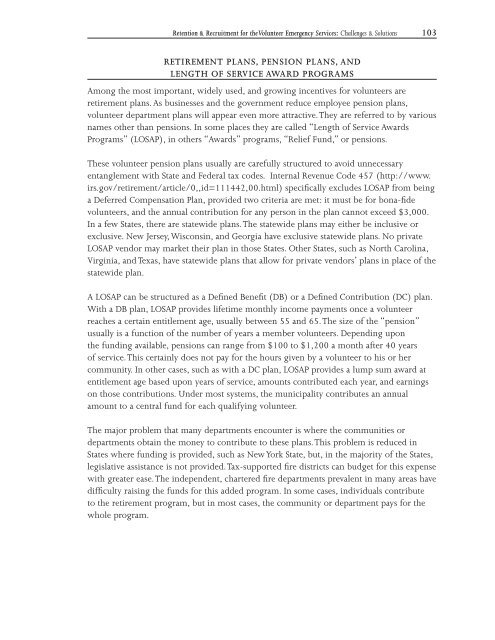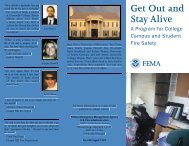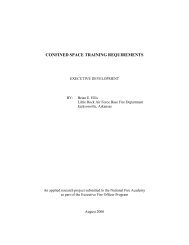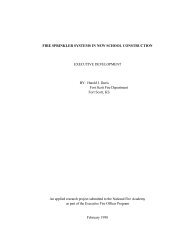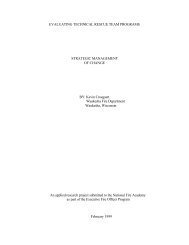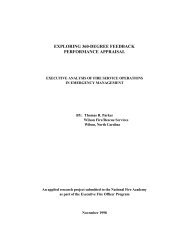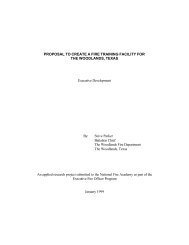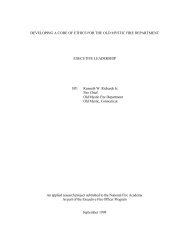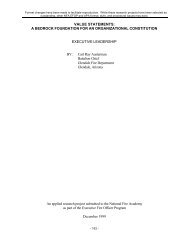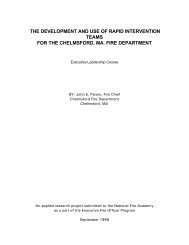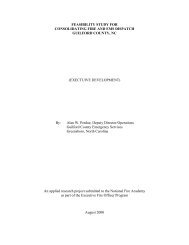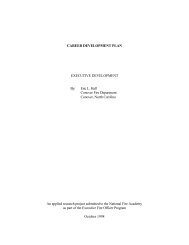Retention and Recruitment for the Volunteer Emergency Services
Retention and Recruitment for the Volunteer Emergency Services
Retention and Recruitment for the Volunteer Emergency Services
Create successful ePaper yourself
Turn your PDF publications into a flip-book with our unique Google optimized e-Paper software.
<strong>Retention</strong> & <strong>Recruitment</strong> <strong>for</strong> <strong>the</strong> <strong>Volunteer</strong> <strong>Emergency</strong> <strong>Services</strong>: Challenges & Solutions 0<br />
RETIREMENT PLANS, PENSION PLANS, AND<br />
LENgTH OF SERVICE AWARD PROgRAMS<br />
Among <strong>the</strong> most important, widely used, <strong>and</strong> growing incentives <strong>for</strong> volunteers are<br />
retirement plans. As businesses <strong>and</strong> <strong>the</strong> government reduce employee pension plans,<br />
volunteer department plans will appear even more attractive. They are referred to by various<br />
names o<strong>the</strong>r than pensions. In some places <strong>the</strong>y are called “Length of Service Awards<br />
Programs” (LOSAP), in o<strong>the</strong>rs “Awards” programs, “Relief Fund,” or pensions.<br />
These volunteer pension plans usually are carefully structured to avoid unnecessary<br />
entanglement with State <strong>and</strong> Federal tax codes. Internal Revenue Code 457 (http://www.<br />
irs.gov/retirement/article/0,,id=111442,00.html) specifically excludes LOSAP from being<br />
a Deferred Compensation Plan, provided two criteria are met: it must be <strong>for</strong> bona-fide<br />
volunteers, <strong>and</strong> <strong>the</strong> annual contribution <strong>for</strong> any person in <strong>the</strong> plan cannot exceed $3,000.<br />
In a few States, <strong>the</strong>re are statewide plans. The statewide plans may ei<strong>the</strong>r be inclusive or<br />
exclusive. New Jersey, Wisconsin, <strong>and</strong> Georgia have exclusive statewide plans. No private<br />
LOSAP vendor may market <strong>the</strong>ir plan in those States. O<strong>the</strong>r States, such as North Carolina,<br />
Virginia, <strong>and</strong> Texas, have statewide plans that allow <strong>for</strong> private vendors’ plans in place of <strong>the</strong><br />
statewide plan.<br />
A LOSAP can be structured as a Defined Benefit (DB) or a Defined Contribution (DC) plan.<br />
With a DB plan, LOSAP provides lifetime monthly income payments once a volunteer<br />
reaches a certain entitlement age, usually between 55 <strong>and</strong> 65. The size of <strong>the</strong> “pension”<br />
usually is a function of <strong>the</strong> number of years a member volunteers. Depending upon<br />
<strong>the</strong> funding available, pensions can range from $100 to $1,200 a month after 40 years<br />
of service. This certainly does not pay <strong>for</strong> <strong>the</strong> hours given by a volunteer to his or her<br />
community. In o<strong>the</strong>r cases, such as with a DC plan, LOSAP provides a lump sum award at<br />
entitlement age based upon years of service, amounts contributed each year, <strong>and</strong> earnings<br />
on those contributions. Under most systems, <strong>the</strong> municipality contributes an annual<br />
amount to a central fund <strong>for</strong> each qualifying volunteer.<br />
The major problem that many departments encounter is where <strong>the</strong> communities or<br />
departments obtain <strong>the</strong> money to contribute to <strong>the</strong>se plans. This problem is reduced in<br />
States where funding is provided, such as New York State, but, in <strong>the</strong> majority of <strong>the</strong> States,<br />
legislative assistance is not provided. Tax-supported fire districts can budget <strong>for</strong> this expense<br />
with greater ease. The independent, chartered fire departments prevalent in many areas have<br />
difficulty raising <strong>the</strong> funds <strong>for</strong> this added program. In some cases, individuals contribute<br />
to <strong>the</strong> retirement program, but in most cases, <strong>the</strong> community or department pays <strong>for</strong> <strong>the</strong><br />
whole program.


